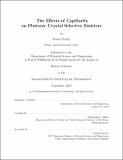The effects of capillarity on photonic crystal selective emitters
Author(s)
Peykov, Daniel
DownloadFull printable version (11.36Mb)
Other Contributors
Massachusetts Institute of Technology. Department of Materials Science and Engineering.
Advisor
Christopher A. Schuh.
Terms of use
Metadata
Show full item recordAbstract
Photonic crystals offer an unparalleled control over optical properties and are ideal candidates as high efficiency selective emitters. They are, however, known to degrade at elevated temperatures through a number of processes, with one of the most notable being surface evolution by capillary forces. By comprehensively simulating the morphological and optical effects of this phenomenon, in the form of surface diffusion, vapor transport, and grain boundary grooving, this thesis seeks to understand its consequences and attempts to pinpoint methodologies that may prevent it. It was shown that while grain boundary grooves have a negligible effect on photonic crystal structures, vapor transport and surface diffusion may be significant. Indeed, vapor transport was found to progressively reduce the dimensions of photonic crystal cavities, and thus slightly alter their optical properties. Conversely, surface diffusion gradually closed o these cavities, thereby eliminating coupling into their resonant modes, and eradicating their selective emission capabilities. Changes to the shape of these photonic crystal structures that decreased their curvature and removed discontinuities were found to be beneficial in inhibiting degradation by capillarity, and an optimized structure that displays both higher efficiency and greater stability over time was ultimately theorized.
Description
Thesis: S.M., Massachusetts Institute of Technology, Department of Materials Science and Engineering, 2014. This electronic version was submitted by the student author. The certified thesis is available in the Institute Archives and Special Collections. Cataloged from student-submitted PDF version of thesis. Includes bibliographical references (pages 60-64).
Date issued
2014Department
Massachusetts Institute of Technology. Department of Materials Science and EngineeringPublisher
Massachusetts Institute of Technology
Keywords
Materials Science and Engineering.